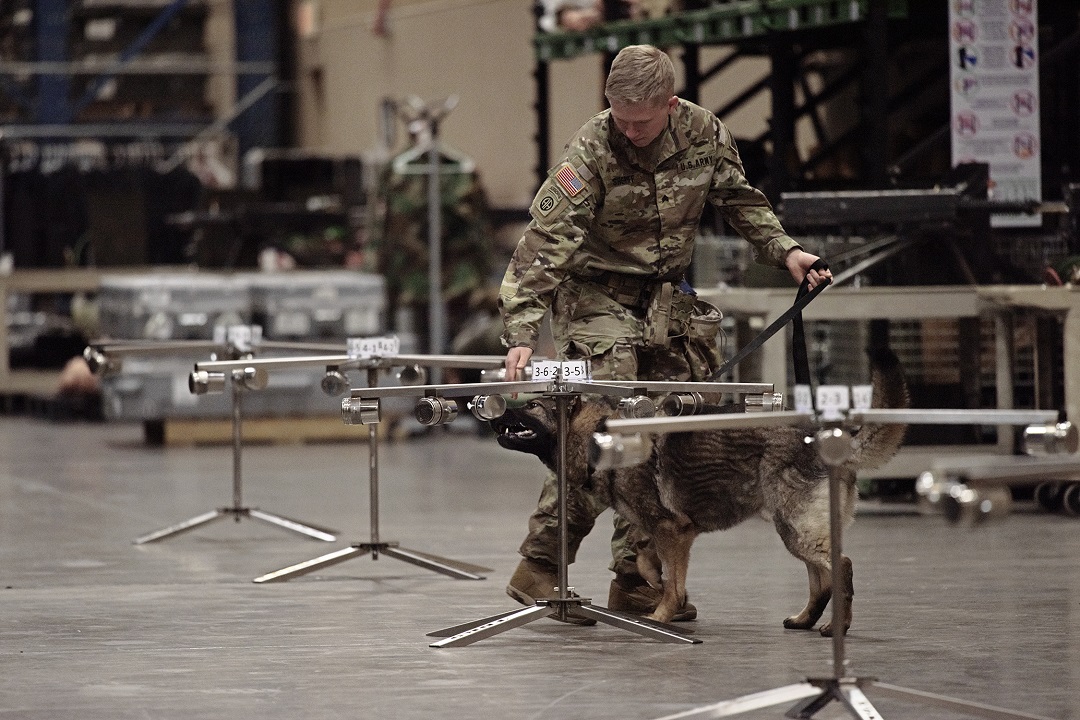// NEWS RELEASE
Emerging Technologies from DEVCOM CBC are Forefront at MSSPIX
CCDC Chemical Biological Center Public Affairs | April 26th, 2023
Emerging Technologies from DEVCOM CBC are Forefront at MSSPIX
DEVCOM CBC Public AffairsApril 26th, 2023

Military Working Dog Handler, Sgt. David Sheriff, and his four-legged partner, Fargo, with the 947th Military Police Detachment (The Old Guard), Washington, D.C., participate in an assessment of a new explosives detection training aid April 6 at the Training Support Center here. The assessment was part of what’s called the Maneuver Support, Sustainment and Protection Integration eXperiments, or MSSPIX, which provides Army leaders and capability developers a chance to gain insights into the viability of emerging technologies through credible and validated operational assessments. (U.S. Army photo by Brian Hill, Fort Leonard Wood Public Affairs Office.)
**Courtesy of the Fort Leonard Wood Public Affairs Office**
FORT LEONARD WOOD, Mo. — More than 20 military working dog teams from across the Army converged on Fort Leonard Wood last week to participate in an assessment of a new explosives detection training aid developed at the U.S. Army Combat Capabilities Development Command’s Chemical Biological Center at Aberdeen Proving Ground, Maryland.
According to Jarrett Ellis, an experimentation engineer at the Maneuver Support Battle Lab here — which falls under Army Futures Command — the assessment was part of the Maneuver Support, Sustainment and Protection Integration eXperiments. MSSPIX, as it’s commonly called, provides Army leaders and capability developers a chance to gain insights into the viability of emerging technologies through credible and validated operational assessments.
“We usually do MSSPIX in May,” Ellis said. “But because this assessment was so resource intensive, we decided to move it into its own week.”
The technology being assessed has the potential to simplify some of the process of training and certifying dogs that sniff out explosives, Ellis said.
“One of the major limitations to training these dogs is that you have to have the explosives on hand,” Ellis said. “If you deploy a dog team somewhere, it’s hard for them to train the dogs and do all the certifications and stuff like that. So, what the folks from the DEVCOM Chem Bio Center did was figure out a way to use an inkjet printer, like you would use in an office, to print explosives on pieces of paper at a very small level — a level where you wouldn’t be able to detonate it.”
Ellis said assessments were conducted indoors at the Training Support Center, near Forney Airfield, as well as outdoors at Training Area 401, where the printed explosive could be buried to simulate sub-surface explosives detection. Two types of explosives were printed for the assessment, Ellis said, but theoretically, any type of explosive could be printed for training purposes.
Staff Sgt. Hector Rodriguez, a kennel master with the Combined Arms Center at Fort Leavenworth, Kansas, was one of the Soldiers chosen to provide feedback on the technology. He called it “a step in the right direction.”
“It’s awesome — the whole concept behind it,” Rodriguez said. “Having those odors on us helps out a lot. They’re replaceable as well, so the continuity stays in those kennels that have them.”
Ellis said bringing the Soldiers who may one day be issued this technology into the development process is one part of what makes MSSPIX valuable to the Army.
“The folks from the Battle Lab, we’re talking to the Soldiers; we’re getting feedback on how this improves what they do on the job,” Ellis said. “Between the Battle Lab and the capability developers, we can really push this in a direction that will suit the Soldiers.”
Rodriguez, who participated in the assessment alongside some of his more junior MWD Soldiers from the CAC, said it feels good to be part of “the big picture.”
“I tell my Soldiers, there’s not a lot of times when a private and his working dog get to support big Army initiatives, making history for the Army,” he said. “So, I think it’s great that there are different departments within our services that are getting after the research and helping our working dogs into the future.”
View the original story here: https://www.army.mil/article/265730/army_working_dog_teams_assist_with_emerging_technology_assessment
The U.S. Army Combat Capabilities Development Command (DEVCOM) leads in the discovery, development and delivery of technology-based capabilities to enable Soldiers to win our nation’s wars and come home safely. DEVCOM is a major subordinate command of the U.S. Army Futures Command. The DEVCOM Chemical Biological Center is the Army’s principal research and development center for chemical and biological defense technology, engineering and field operations. The DEVCOM Chemical Biological Center is headquartered at Aberdeen Proving Ground, Maryland.
